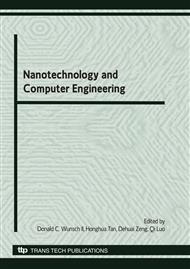[1]
Qiang xu, Qizheng Liao. Construction Principle and Torque Solution of the Translational Meshing Motor,. International Conference on Mechatronics and Automation. August 5-8, 2007, Harbin, China. Page2894-2899.
DOI: 10.1109/icma.2007.4304019
Google Scholar
[2]
Y. Hori, Comparison of torsional vibration controls based on the fast and slow disturbance observers, in Proc. 1995 Int. Power Electronics Conf., pp.440-446.
Google Scholar
[3]
S. Ouchi, T. Mita, and K. Yano, Active vibration control of a motor system by using H control theory, IEEJ Trans. Ind. Applicat., vol. 113-D, no. 3, pp.325-332, (1993).
DOI: 10.1541/ieejias.113.325
Google Scholar
[4]
J. K. Ji, S. K. Sui, and M. H. Park, LQG based speed controller for torsional vibration suppression in 2-mass system, " in Proc. IEEE IECO
, 93, 1993, pp.1157-1162.
Google Scholar
[5]
Y. Hori, H. Sawada, and Y. Chun, On optimal estimation speed of disturbance observer used in the slow resonance ratio control, IEEJ Trans. Ind. Applicat., vol. 117-D, no. 1, pp.50-56, (1997).
DOI: 10.1541/ieejias.117.50
Google Scholar
[6]
S. Hashimoto, H. Funato, and K. Kamiyama, Torsional vibration suppression control in a three-mass motor drive by first-order H speed controllers, in Proc. 7th Int. Power Electronics Motion Control Conf., vol. 1, 1996, pp.115-119.
Google Scholar
[7]
Lachman T, Mohamad T R, Fong C H. Nonlinear modelling of switchedeluctance motors using artificial intelligence techniques[J]. IEE Proc. -Electr. on Power Appl., 2004, 151(1): 53~60.
DOI: 10.1049/ip-epa:20040025
Google Scholar
[8]
K. S. Narendra and K. Parthasarny, Identification and control of dynamical systems using neural network, IEEE Trans.
eural
etworks, vol. 1, pp.4-27, Mar. (1990).
Google Scholar
[9]
I. Husain and MEhsani, Torque Ripple Minimization in Switched Reluctance Motor Drives by PWM Current Control, IEEE APEC Records, pp.72-77, (1994).
DOI: 10.1109/apec.1994.316417
Google Scholar
[10]
P. Tandon, A.V. Rajarathnam, M. Ehsani, Self-Tuning Control of Switched Reluctance Motor Drive with Shafi Position Sensor, IEEE Transactions on Industry Applications, Vo1. 33, No. 4, July/August, 1997, pp.1002-1010.
DOI: 10.1109/28.605742
Google Scholar


